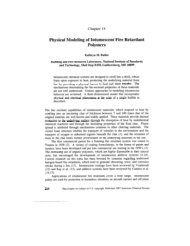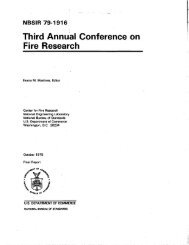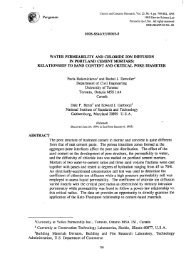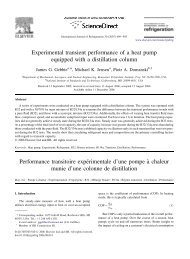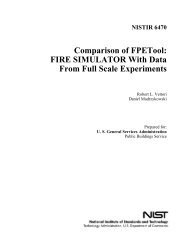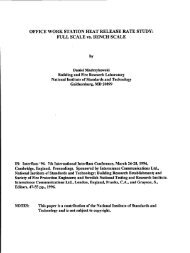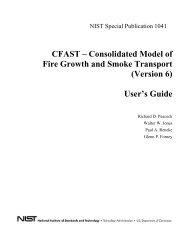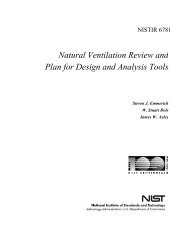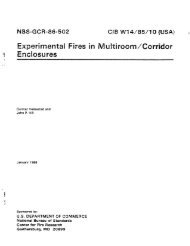Study of Technology for Detecting Pre-Ignition Conditions of ... - NIST
Study of Technology for Detecting Pre-Ignition Conditions of ... - NIST
Study of Technology for Detecting Pre-Ignition Conditions of ... - NIST
Create successful ePaper yourself
Turn your PDF publications into a flip-book with our unique Google optimized e-Paper software.
.<br />
.<br />
.<br />
attenuation trends, and heating periods were similar <strong>for</strong> each <strong>of</strong> these tests.<br />
3.9 Re-<strong>Ignition</strong> Behavior<br />
CPSC-JAG95-1145<br />
Re-ignition occurred frequently <strong>for</strong> the tests with oil cooked on the electric range in<br />
stainless steel pans after the oil was extinguished with the lid. The residual heating ability <strong>of</strong> the<br />
de-energized electric burner built up very high temperatures within the closed pans. Attention<br />
should be given to this phenomenon because current recommended safety practices may not take<br />
it into account. A high capacity fire extinguisher maybe necessary to completely extinguish such<br />
a fire with or without initial extinguishment with the lid.<br />
4.0 Literature Search<br />
4.1 Objectives<br />
The second major activity <strong>of</strong> this project was the identification <strong>of</strong> methods, materials, and<br />
devices with potential to detect and react to pre-ignition conditions. This was accomplished with<br />
a literature and patent search. The search focused on technologies capable <strong>of</strong> detecting one or<br />
more cooking-related signatures and the control technologies capable <strong>of</strong> shutting <strong>of</strong>f gas and<br />
electric ranges in the event <strong>of</strong> a danger signal from a detector. The bibliographical reference<br />
itiormation related to these technologies is provided in Append~x A.<br />
4.2 Search Databases and Strategies<br />
4.2.1 Databases<br />
The databases that were searched were <strong>NIST</strong>’S fire document collection (FIREDOC),<br />
Engineering Index (EI), National Technical In<strong>for</strong>mation Service (NTIS), and Derwent World<br />
Patent Index (WPI). FIREDOC is a database managed by the Fire Research In<strong>for</strong>mation Services<br />
at <strong>NIST</strong>. The documents contained in FIREDOC primarily are related to fire, smoke, flame, and<br />
combustion fields, although the database has started to include research literature associated with<br />
building technology as well. FIREDOC was the primary resource <strong>for</strong> investigating technologies<br />
related to smoke detection because the subject has been thoroughly researched and documented<br />
at <strong>NIST</strong> and elsewhere. FIREDOC was not helpfi.d at all, however, in the investigation into<br />
control technologies.<br />
The EI and NTIS databases, while covering the broad range <strong>of</strong> all scientific research, also<br />
contain several orders <strong>of</strong> magnitude more papers than FIREDOC. These databases were very<br />
helpfil in finding research reports that are indirectly related to or unrelated to fire or smoke, but<br />
could have bearing on this project’s objectives. NTIS also contains literature that has limited<br />
publication and distribution. EI and NTIS were more helpful than FIREDOC in obtaining<br />
controls references. The detector patent search was limited to smoke detectors. A controls search<br />
was also conducted using the patent database.<br />
61



